While there have been posts about other games hidden amongst the deluge of Halo Fest 2020 related content here, I’ve actually played a lot of other things I’ve yet to post about. Here’s a quick catch-up of random things I’ve actually finished, with several others coming in future posts when I eventually wrapped them up.

“In the midnight hour though, I have as many friends as I like.” – Online Gamer”
First up is The Infectious Madness of Doctor Dekker. I’ve had most of Wales Interactive’s more notable FMV games on my wishlist ever since playing Late Shift. Doctor Dekker, however, is something a bit different from my first foray into modern FMV games. While Late Shift is very cinematic, playing something like an interactive movie, Doctor Dekker mostly consists of very short clips, almost always focusing on a single subject from a static first person perspective. This works well with the premise of the game, as you’re supposed to be a psychiatrist interviewing various patients in your office. A patient sits on your couch. You ask a question, and you get an answer. Simple.
Mechanically, just choosing questions from a dialog tree might be a little too simplistic to be entertaining, and Doctor Dekker attempts to solve this by having the player freely type their questions. Or, at least, it does in the PC version. You see, I played this on my Xbox Series X, and from what I understand the console versions of Doctor Dekker largely dumb this feature down, allowing you to select most of the more obvious questions and follow-up questions from a list. This works… okay. In fact, what I took issue with was when the game indicated that there was more to learn without showing me any new questions, meaning I was forced to type one in. Call me spoiled by 40 year old text adventure games, but man, this game’s text parser is hot garbage. I’d ask very obvious questions, even some I was absolutely positive were follow-ups to previous answers, yet 9 out of 10 times I’d get back a short FMV sequence equivalent to “huh?!” Still, other times I might get a wildly random response that didn’t seem related to what I asked at all. It seems like it’s looking for a limited number of keywords and keyword combinations rather than understanding grammar or at least having a massive list of acceptable synonyms. I also strongly suspect there was some degree of intention behind having us play “guess the keyword” as something of a puzzle. Regardless, fighting a bad parser is never fun.

“Interviewing the ever popular Marianna.”
While the format is a little limited, there’s a larger murder mystery plot with some (not at all subtle) shades of Cthulhu mythos, including a very minimal insanity system, all unraveled by questioning these patients to learn more about their backgrounds, their relationships with the victim, and ultimately investigating if they, or another of your patients, might be the killer. The actors were mostly pretty good, or at the very least fun to watch as you get to know what are ultimately all pretty wacky characters. The way the story unfolds day by day also did a good job of stringing me along as I learned more. The ending was a little unsatisfying, in that there seemed to be multiple equally viable candidates for who the killer could be, and it felt like the game simply picked one of them at random to be valid for this playthrough. That said, doing a little reading, it does seem that there can be a decent amount of deviation for each patient depending on how you choose to answer certain questions they ask of you along the way. Neat.
Overall, I definitely didn’t find The Infectious Madness of Doctor Dekker to be as enjoyable as Late Shift, but I certainly didn’t find it objectionable enough to steer me away from checking out other similar games in the future.
Moving on, I picked up Warhammer 40,000: Darktide on PC at its launch. For those that don’t know, Darktide is something of a sequel to the two Warhammer: Vermintide games. Being based in the far flung grim-dark universe of Warhammer 40k versus the high fantasy world of Warhammer Fantasy, it still follows Vermantide’s Left 4 Dead influenced style of character/class-based cooperative action. While there are a ton of systemic differences, both minuscule and quite large, I feel like comparing it to Left 4 Dead alone does a pretty accurate job of summing up the gameplay of these titles.
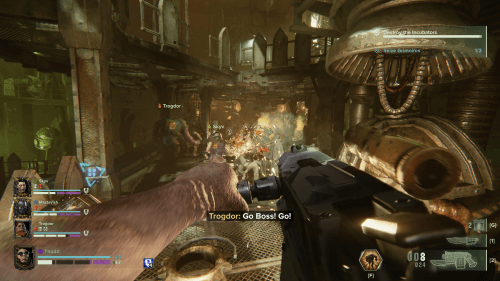
“My Orgryn Thudd and his beloved Ripper.”
I haven’t played a lot of cooperative games like this outside of playing L4D with friends way back in the day, and despite being a huge Warhammer fan, I’ve yet to play either of the Vermintide games since it seems most of my gaming friends have moved on from the genre. Playing Darktide with randoms is incredibly easy though, and I found people purposely being assholes, trolling, or otherwise not playing the game properly to be quite rare. Of course, teamwork with a bunch of random people, usually without voice communications, is nowhere near as fun, but I found it to be enjoyable enough. Perhaps my favorite part of Darktide though, was simply how amazing of a job Fatshark did with representing the gritty violence of the Warhammer 40,000 setting in first person. It’s a great looking game absolutely bursting with atmosphere. The classes are all pretty fun, as is customizing and upgrading your characters.
That all said, I found the gameplay loop to get a little repetitive. Progression is reasonably fast, but still, slogging through the same (or very similar) oppressive feeling maps over and over again feels a bit too much like a treadmill. I might have stuck with it if I were playing with friends, and while I ultimately still like the game, I put it down after only around 15 hours of playtime. Perhaps I’ll return if I see some compelling updates though.
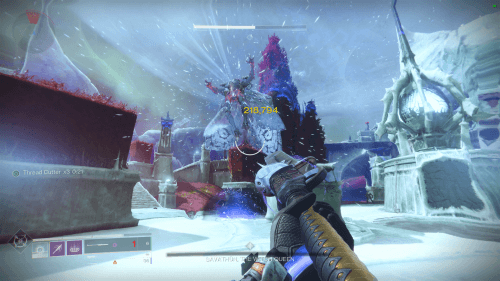
“Spoilers: She dies.”
Speaking of grinds, I briefly returned to Destiny 2 (PC) late last year, just long enough to catch up from where I left off, and finally played through The Witch Queen campaign. I had a great time as usual, but the start of my burn out just happened to coincide with the announcement of the Lightfall expansion, which didn’t look too appealing to me for numerous admittedly petty reasons. From the current community backlash, perhaps I dodged a bullet?
Another repetitive online FPS that I bounced off of recently was Meet Your Maker. How do I describe Meet Your Maker? Hmm. Well, imagine a very Quake 1+2 influenced FPS (in terms of visuals, some of the enemy and weapon designs, and having a sweet grappling hook which my brain will apparently always associate with old Quake mods) in which you “raid” random procedurally designed dungeons / bases (called outputs) filled with enemies and traps. Your goal is to make it deep into the outpost, grab the loot stash therein, and then make your way back out alive (which is easier said than done, since some new monsters and traps might show up after you nab said loot.) The loot you gain from these raids can be used to upgrade your character, weapons, etc.
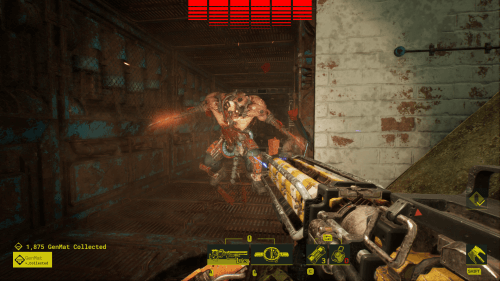
“With only one shot left, I better not miss.”
Now imagine that these dungeon base things aren’t actually procedurally generated, but designed and constructed by other players, using some of the loot from their own raids to add and upgrade more traps and enemies, expand and redesign their outpost, and build secondary outposts, and of course, you can do the same. I personally love the idea of these sort of dueling asymmetrical gameplay systems, and I’m always down for systems where players can get creative by adding their own content to the world (providing they’re not abused too much.) Building your own outpost maps, while understandably a little limited, is pretty fun, but watching replays of other players raid my outposts and navigate my traps? Amazingly entertaining! I don’t think of myself as a cruel or particularly vindictive person, but Meet Your Maker had me practically falling out of my chair, literally laughing out loud on more than one occasion after watching some hapless player wander into a particularly diabolical trap. Pure, albeit slightly evil, joy.
Personally, I always tried to make my outposts some degree of “fair” and I feel like others do as well, though when raiding you do occasionally wander into a outpost that was designed to be almost impossible, making them painstakingly slow to navigate through. Raiding in Meet Your Maker tends to lead to a uniquely cautious approach to exploration and navigation anyway, at least until you learn a lot of the more common tricks players use and how to deal with them, so if you make your outpost too stupid most players will probably just bail on it after a few deaths. I tend to get obsessed with conquering them though. Back at the hub area, which is something of a diegetic, in-game world menu, you get a taste of the fiction around all of this, which I actually found pretty interesting. Just as with Darktide though, it’s largely just set dressing to make the grind of the gameplay a bit easier to swallow and as far as I can tell there’s nothing in the way of a plot to advance through.
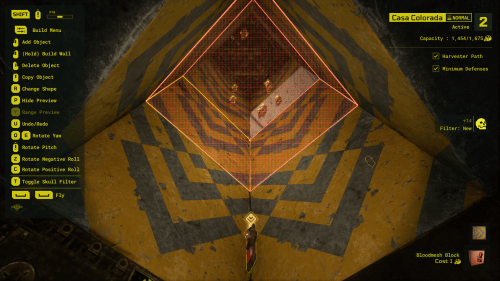
“A fav, vertical shaft with multiple traps at each end. No one can resist a shortcut!”
I really love the game, but after 25 hours or so, that grind is ultimately why I’m not still playing Meet Your Maker. The resource requirements to upgrade your character and particularly to keep your outposts up and running seem far too punitive, even if you really enjoy the raiding gameplay. Even ignoring that, just like Darktide, the gameplay is definitely repetitive, so some degree of burnout is bound to happen. I will surely return to it in the future, though I’m afraid its player count might have dwindled precipitously by then, which would be a huge problem for a game so heavily dependent on player made content. A game with a strikingly similar design, The Mighty Quest for Epic Loot, had the same struggles, and was shuttered before ultimately being reworked into an almost entirely different game, leaving the hardcore fans of the original feeling totally abandoned by Ubisoft. I hope Meet Your Maker has a better fate.
And now for something completely different… *desk blows up*
It Takes Two was a hot topic on some of my favorite gaming podcasts, and coming from Josef Fares and the rest of the team that brought us the impressive A Way Out, it was an easy addition to my backlog. Somehow my partner also found out about it and wanted to play it just as much as I did. Definitely a good omen for a cooperative game, no? Like A Way Out, It Takes Two is a dedicated co-op game (I mean, hell, it’s in the name!) and has been designed from the ground up to be played that way, either split screen or online, and generously even offers a free pass for the latter scenario, meaning only one of the two players has to own the game. Awesome.
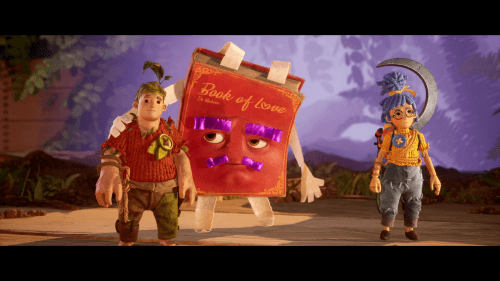
“Your tormentor, Dr. Hakim.”
The two players fill the shoes of Cody and May, a husband and wife in the midst of a divorce who are magic’d into their daughter’s weird little toy doll versions of themselves. They need to work together to escape the terrifying Honey, I Shrunk the Kids-esque massively scaled version of the world and break their daughter’s evil curse, all while being taunted mercilessly by Dr. Hakim, an anthropomorphized relationship advice book. While I’m being slightly hyperbolic here, that’s about the gist of it.
You can probably already guess that by working together, the couple will slowly rediscover their feelings for each other and end up reunited, and while that’s how it goes down on paper, I don’t think their reconciliation is quite as smooth in the game itself. That is, there were tons of opportunities to show Cody and May growing closer, dealing with old wounds, rekindling passions, etc. but I don’t feel like it does a great job of presenting this gradual process. Instead, there are moments, specific lines of dialog, etc. that relay some of this, but you don’t really see the characters progress all that much. Despite this, the game ends as predicted and (sarcastic spoiler warning) the family ends up sticking it out and living happily ever after. While sweet and all, the game did actually do a pretty good job at showing us that the couple has some major compatibility issues and that maybe their divorce was actually warranted. Oh well!
I’m being pretty critical here, because that might be my only real complaint about the entire game, and it’s not even that notable. Honestly, the story could just be a total contrivance to set up the game, and while there were some interesting, even slightly emotional narrative moments, it largely takes a backseat to the incredibly fun gameplay. Unless you utterly hate the story or the characters, I don’t think this is likely to factor heavily into your enjoyment of the game.
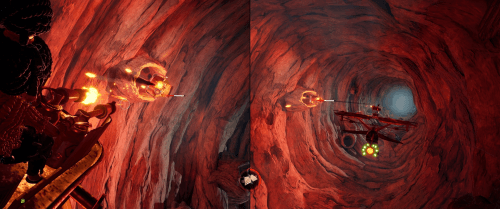
“Classic co-op action, with one player flying and one gunning.”
As far for that gameplay, It Takes Two fits the classic 3D platformer mold pretty cleanly. I don’t even think I remember the last one of those I played, but as an Nintendo 64 owner in the 90s, trust me when I say I’ve played my share of them. The genre has always been a mixed bag for me. Light narratives featuring wacky characters, with some puzzle solving, exploration, and adventure? All pretty fun stuff. Difficult platforming, however, can be extremely frustrating to me, and lots of it? Tedious. No worries though, as the basic mechanics of It Takes Two are great. It’s smooth, responsive, and just the right level of forgiving. That’s not to say there aren’t some potentially challenging moments, and I was worried that my partner might have difficulty as, while she plays plenty of games, platformers aren’t really her wheelhouse, but there were few if any moments in the game where she struggled. It’s all fairly intuitive, and always being able to figure things out with another person further helps this (which I suppose is appropriately meta.)
The game isn’t all just jumping around though. Many of the puzzles and other obstacles to navigating the world rely on some pretty clever mechanics, and It Takes Two takes the unusual approach of adding new ones and mixing up or replacing old ones constantly. In fact, the major stages and numerous smaller sections of the game have their own set of puzzle solving and/or navigation mechanics, from things like grinding on rails, riding on creatures and objects, to shrinking yourself and reversing time. Cody and May usually have their own distinct sets of abilities on each stage too, and they can typically be combined. For example, in one area early on, Cody gets the ability to shoot sticky sap which damages and slows certain enemies, and can be used to hold or weigh down objects. May gets the ability to shoot an incendiary projectile, which she can use for pinpoint shots, but more importantly, causes Cody’s sap to violently explode. These abilities need to be used both separately and in-conjunction in a variety of creative ways. Even if one of these mechanics doesn’t gel with you, it’s not usually long before you’re onto something else, which given the game’s length, clocking it at somewhere around 14 hours, is definitely a good thing.
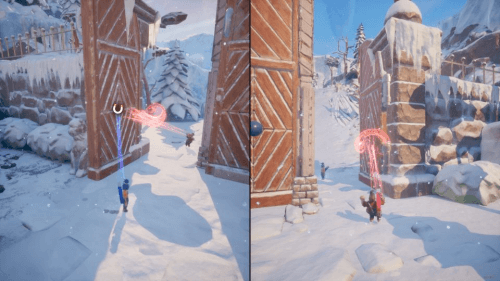
“Using their special magnets, one player has to push the door open while the other has to pull it.”
In addition to the variety of mechanics, there’s also something like 25 minigames hidden throughout the stages. These minigames really just serve as a bit of a fun distraction, further breaking up the gameplay and interrupting the cooperation with some brief moments of head to head competition. Once you find a minigame it unlocks it to be played from the main menu any time you want, too. Sure, not all of them are amazing, but my biggest complaint about the minigames is that some of them are a little too hidden, and missing out on one entirely just because you didn’t happen to stumble across it is definitely a bit of a bummer. I think we missed several during our playthrough, actually.
I’ve used the word “variety” several times now, and the aesthetics of the different stages and sub areas of the game are equally as diverse. Honestly, the entire game looks absolutely fantastic; stylized just enough, featuring great animation across the board, and all running silky smooth on my Series X to boot. Voice acting (and the writing) of individual lines is great too, as are the sound effects. It’s one of those great games that feels almost like a AAA title while it clearly wasn’t one. I honestly think we need a lot more of those; there seems like there’s plenty of fertile middle ground between tiny indie projects and massive, big budget AAA hits for games with good budgets and talented teams to be able to produce quality titles with modest sales goals (which, indubitably, will occasionally be shattered.) It Takes Two is a fine example of this, winning several GOTY awards and apparently selling over 10 million copies so far.
Anyway, off my soapbox for now. It Takes Two might just be one of the best co-op games ever created, and it should be on literally everyone who enjoys even the occasional co-op experience’s list. How’s that for a summary?
Screenshots from Doctor Dekker and It Takes Two swiped from Steam Community posts because I forgot to take my own. Ooops.